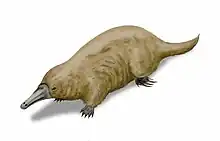Murrayglossus
Murrayglossus is an extinct echidna from the Pleistocene of Western Australia. It contains a single species, Murrayglossus hacketti, also called Hackett's giant echidna. It is known only from a few bones.[1] It is estimated to have been about 1 m (3.3 ft) long[1] and probably weighed about 30 kg (66 lb).[2] This makes it the largest monotreme known to have ever lived. Historically treated as a species of long-beaked echidnas,[1][3] it was separated into its own genus Murrayglossus in 2022. The generic name combines the last name of paleontologist Peter Murray and glossus, the Greek word for "tongue".[4]
| Murrayglossus Temporal range: Pleistocene | |
|---|---|
 | |
| Life reconstruction | |
| Scientific classification | |
| Domain: | Eukaryota |
| Kingdom: | Animalia |
| Phylum: | Chordata |
| Class: | Mammalia |
| Order: | Monotremata |
| Family: | Tachyglossidae |
| Genus: | †Murrayglossus Flannery et al., 2022 |
| Species: | †M. hacketti |
| Binomial name | |
| †Murrayglossus hacketti (Glauert, 1914) | |
| Synonyms | |
| |
Description
.png.webp)
At around 1 m (3.3 ft) long, 0.6 m (2.0 ft) tall and about 30 kg (66 lb), M. hacketti was the largest monotreme known to have existed.[1] M. hacketti had longer, straighter legs than any of the modern echidnas. Augee (2006) speculates that this feature made the animal more adept at traversing through thickly wooded forests.[1] The main diagnostic characteristics of genus Murrayglossus are a set of femoral traits: a low femoral head; the very low position of the lesser trochanter relative to head (situated directly below the internal margin of the femur); the large trochanter that has a high position relative to the head; a flared medial epicondyle; and obliquely oriented condyles.[4]
Discoveries
Fossils of Murrayglossus hacketti were discovered in Mammoth Cave, Western Australia, and excavated in 1909. They were found mixed with the remains of other taxa such as Sthenurus and Macropus. Australian paleontologist Ludwig Glauert described the fossils in a 1914 publication. The specific epithet hacketti honours John Winthrop Hackett, "as a slight acknowledgement of his generous support which alone rendered the exploration of these caves possible."[5]. The material is poor, mostly vertebra and leg bones, and the cranial material is completely absent, making M. hacketti's historical classification into the genus Zaglossus uncertain.[1] Some of the fossils have incisions and burn marks, suggesting that M. hacketti was at least occasionally hunted by humans.[6]
Aboriginal rock art found in Arnhem Land in the Northern Territory may represent M. hacketti or the extant western long-beaked echidna (Zaglossus bruijni).[7][8]
References
- Augee, M. L.; Gooden, B.; Musser, A. (January 2006). Echidna: Extraordinary Egg-laying Mammal. Csiro Publishing. pp. 18–20. ISBN 978-0-643-09204-4. OCLC 65199910.
- "Zaglossus hacketti - extinct giant echidna". Megafauna. Tourism Western Australia. Archived from the original on 26 January 2014. Retrieved 28 April 2014.
- Siegel, J. M.; Manger, P. R.; Nienhuis, R.; Fahringer, H. M.; Shalita, T.; Pettigrew, J. D. (June 1999). "Sleep in the platypus" (PDF). Neuroscience. 91 (1): 391–400. doi:10.1016/S0306-4522(98)00588-0. PMC 8760620. PMID 10336087. S2CID 18766417.
- Flannery, T. F.; Rich, T. H.; Vickers-Rich, P.; Ziegler, T.; Veatch, E. G.; Helgen, K. M. (2022). "A review of monotreme (Monotremata) evolution". Alcheringa: An Australasian Journal of Palaeontology. 46: 3–20. doi:10.1080/03115518.2022.2025900. S2CID 247542433.
- Glauert, Ludwig (1914). "The Mammoth Cave (continued)". Records of the Western Australian Museum and Art Gallery. 1: 244–251.
- Archer, Michael; Crawford, Ian M.; Merrilees, Duncan (1980). "Incisions, breakages and charring, some probably man-made, in fossil bones from Mammoth Cave, Western Australia". Alcheringa: An Australasian Journal of Palaeontology. 4 (2): 115–131. doi:10.1080/03115518008619643.
- "Megafauna cave painting could be 40,000 years old". ABC News. Australian Broadcasting Corporation. 31 May 2010. Retrieved 31 May 2010.
- Gunn, R. C.; Douglas, L. C.; Whear, R. L. (2011). "What bird is that? Identifying a probable painting of Genyornis newtoni in Western Arnhem Land". Australian Archaeology (73): 1–12.
- Long, J. A.; Archer, M.; Flannery, T.; Hand, S. (2002). Prehistoric Mammals of Australia and New Guinea: One Hundred Million Years of Evolution. Johns Hopkins University Press. p. 107. ISBN 978-0-8018-7223-5. OCLC 49860159.



